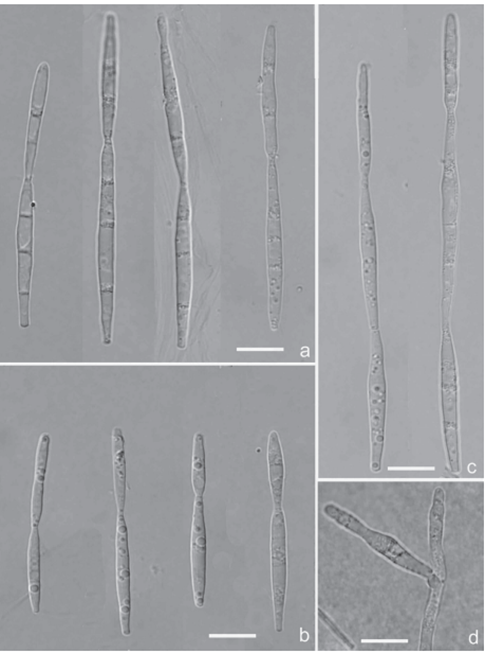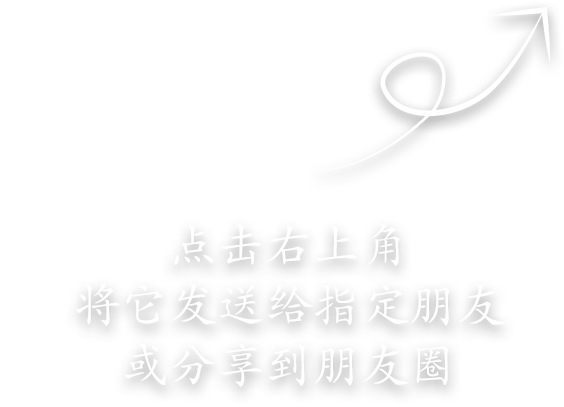 81
81
Isthmomyces dissimilis Z. F. Yu, M. Qiao & R. F. Castañeda, sp. Nov.2021
Index Fungorum number: IF556129
Facesoffungi Number No: FoF05743
Holotype YMF 1.04604
Morphological description :
Asexual morph: hyphomycetous. Colonies on CMA white to dark salmon, reverse pale yellow, attaining 2.5 cm diam. after 20 days at 25 °C. Mycelium superficial or immersed, composed of branched, septate, brown, hyphae. Conidiophores macronematous, mononematous, erect, straight, unbranched or slightly branched, 0–1- septate, smooth, subhyaline13.8–51 × 2.3–3.2 µm. Conidiogenous cells polyblastic, ampulliform to cylindrical, sympodial extended, integrated, terminal, subhyaline. Conidia acrogenous, isthmospore, with inconspicuous isthmus, (isthmus mostly reduced to being constricted at the septa) subhyaline, guttulate, smooth, composed of 2–3-cellular isthmic-segments, more or less symmetrical: A) the larger isthmospore with 2-cellular isthmic-segments: i) basal isthmic-segment cylindrical-fusiform, truncate below, 1–3 septate, 35–60 × 4–4.5 µm, ii) apical isthmic-segment fusiform, rounded at the tip, 0–2 septate, 17–36.5 × 4–4.5 µm; total long 70–95 µm. B) the smaller isthmospore with 2-cellular isthmic-segments: i) basal isthmic-segment cylindrical-fusiform, truncate below, 0–1 septate, 23–33 × 3.5–4.5 µm; ii) apical isthmic-segment fusifor rounded at the tip, 0–1 septate, 17–22 × 3.5–4.5 µm; total long 47–57 µm. C) isthmospore with 3-cellular isthmic-segments: i) basal isthmic-segment fusiform, truncate below, 2–3-septate, 18.5–38.5 × 2.8–5.0 µm; ii) central isthmic-segment cylindrical-fusiform, 2–3-septate, 20.1–44.5 × 3.0–6.2 µm; iii) apical isthmic- m, segment fusiform, rounded or obtuse at the tip, 0–2-septate, 17.4–31.6 × 2.3–4.8 µm.
Sexual state: unknown.
Culture characteristics:
Habitat: on submerged leaves,
Distribution: China, Hainan Province, Diaoluo Mountain Nature Reserve,
GenBank: lsu MK577811; its MF740794.
Notes. The new species, Isthmomyces dissimilis, varies in conidial shape. Although it has 3-cellular isthmic-segment conidia, its isthmic-segment is not as distinct as Isthmolongispora species. However, the cells of Isthmolongispora are bead-like, while those of I. dissimilis are cylindrical to fusiform.
Reference:[1] Qiao, M. , Zheng, H. , Guo, J. S. , Castaeda-Ruiz, R. F. , Xu, J. P. , & Peng, J. , etal. (2021). Two new asexual genera and six new asexual species in the familymicrothyriaceae(dothideomycetes, ascomycota) from china. MycoKeys, 85, 1-30.

Isthmomyces dissimilis (Holotype YMF 1.04604) a the larger isthmospore with 2-cellular isthmic-segments b the smaller isthmospore with 2-cellular isthmic-segments c isthmospores with 3-cellular isthmic-segments d conidiogenous cell and developing conidia. Scale bars: 10 µm (a–d)

